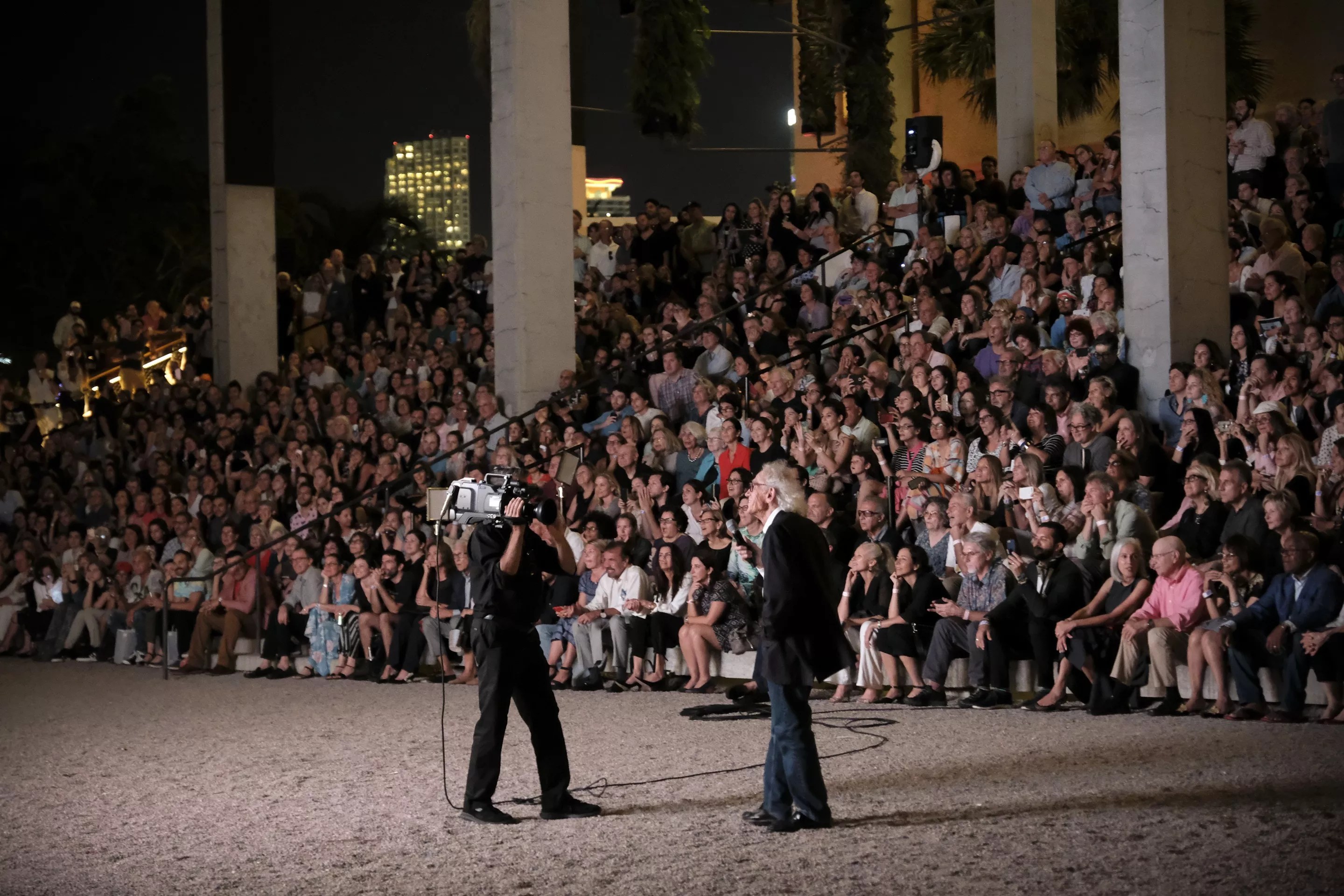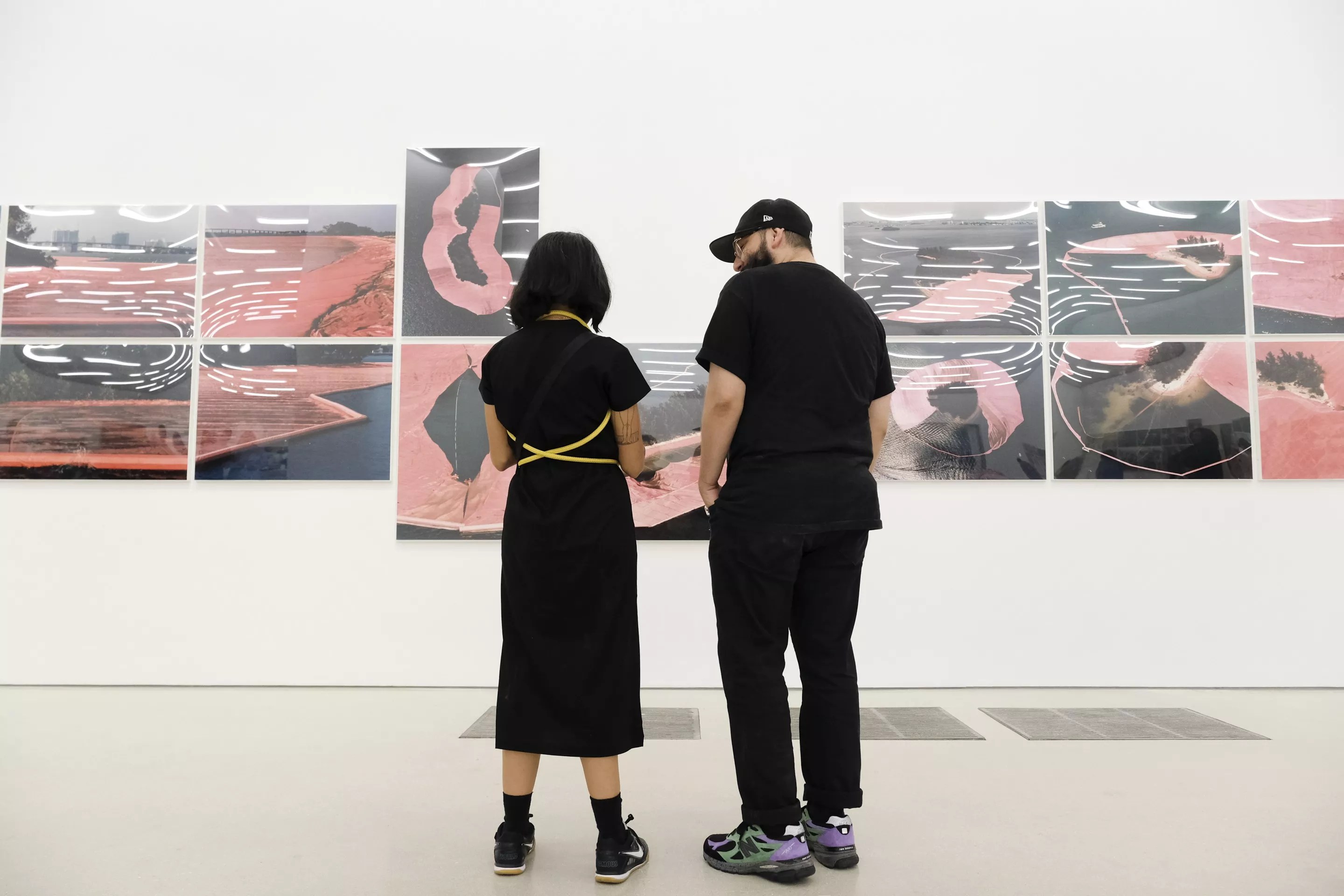
Audio By Carbonatix
Even before Pérez Art Museum Miami’s big opening night for the exhibition of historical and archival materials from Christo and Jeanne-Claude’s Surrounded Islands, it was clear this would be a different kind of show. As Christo himself said during a private tour a few days before the official opening: “This is not a normal exhibition. It’s a documentary exhibition – it goes beyond a work of art. It’s more like a museum of natural history.”
By the day of the event, hours before Christo would host a
The hue of the scene started to change as people began to arrive in every shade of pink. Women wore pale-pink dresses and
When Christo took the stage, he was met with roaring applause and fanfare, which came as no surprise. Aside from being one of the most famous, established, and respected artists on the planet, this man changed Miami. It could be argued that he and his late wife helped give birth to the Miami we know today. PAMM, for instance, shares its birthday with the anniversary of Surrounded Islands‘ completion. The very museum where all of these people came to see Christo speak might not exist if not for his work.

View more photos of Christo at P
Photo by FujifilmGirl
Many attendees were more taken with the artist than the exhibition. That’s not only because Christo is a living legend of the art world but also because he is a fascinating and extremely likable individual. He is passionate but not pretentious, direct but not condescending, intelligent and cultured in the extreme but not at all haughty. There are very few men like Christo, masters of their craft whose credibility is above question. And there are fewer still who are as affable and down-to-earth.
After a brief slideshow of the projects he and Jeanne-Claude have produced over the years (at one point the slideshow froze, and rather than pout, Christo made jokes about problems with machines), the artist opened the floor to questions. One of the most remarkable things about Christo is his eagerness to engage. For hours, he fielded all manner of questions and answered in great detail, from describing the minutiae of how he works with banks and buyers to finance his projects, to how he and his team tested the polypropylene fabric at a secret site in Key Largo. There was also talk of the time they covered a tank at an Orlando aquarium with the material to see how the manatees would react, and found that the gentle giants preferred mating under the pink sheets.
Inside PAMM, the exhibition is located in the gallery space for special shows on the second floor. After entering, you’re immediately greeted by a 15-foot-tall map of Biscayne Bay, reproduced in stark black-and-white, save for undulating bits of bright pink encircling the spoil islands of the Intracoastal. On the wall beside the map, Christo and Jeanne-Claude, both young and windswept, stroll together on the sands of Miami. The photos of the couple are a fitting way to open the exhibition – they give a real sense the artists were at the outset of something grand.
This corridor is also where the exhibition offers its first glimpses of Christo’s sketches for Surrounded Islands, though the word “sketches” is a bit misleading. These drawings are immense, the kind of things you must see for yourself. Stand in front of them and imagine Christo – his long, thin fingers grasping a piece of pink pastel in his workspace in Lower Manhattan – coloring these floating skirts that he and his wife had imagined around the islands.
Hugo Lopez vividly recalls the first time he saw Surrounded Islands as a boy in Mexico City. “I actually remember when I was 5 years old seeing the work on the cover of a magazine. Little did I know that 15 years later, I would move to Miami and that I would see this in person.” Speaking of the way the exhibition strikes him all these years later, Lopez says, “I have goose bumps… Seeing the exhibition, realizing the scope of it, it’s actually much more impressive than the pictures showed all the way back then.”

View more photos of Christo at P
Photo by FujifilmGirl
The next room is divided in two. One wall is made up almost entirely of maps of Biscayne Bay, some created by the U.S. Geological Survey, some created by Christo and Jeanne-Claude’s team. The materials on this wall, which also include plans for how to affix the polypropylene sheets to the floating booms around the islands and how to anchor them to the bottom of the bay, shows some of the extraordinary engineering work that went into making this project possible.
The opposite wall shows Christo and Jeanne-Claude’s battles to obtain city, county, state, and federal permission to realize the installation. There are photographs of meetings, illustrations of courtroom hearings, and original documents, such as affidavits filed by marine biologists affirming the project would be safe and rulings handed down stating just how Christo and Jeanne-Claude would be allowed to carry out their plans. According to Christo, there were many times during these hearings when he was so furious that Jeanne-Claude would make him wait outside while she stayed to participate.
Roger Abramson, a Miami Beach artist who is perhaps best known for creating the giant menorah and dreidel covered in seashells on Lincoln Road, is quick to point out that Surrounded Islands probably couldn’t have been made in modern Miami. “It’s probably one of the most amazing events that ever happened in Miami-Dade County. To be able to put this together today would be virtually impossible… I think it gave Miami a whole new outlook. All of a sudden, Miami was coming to life.” For Abramson, Christo and Jeanne-Claude’s work takes on even greater significance in light of the exhibition. “I’ve gotten much more of an appreciation [for Surrounded Islands]. It was more than an exhibit. I’ve been an artist more or less my entire life, and most exhibits, you put up a painting here and there, but
When you leave this part of the exhibition and pass through an anteroom with several more sketches, you come to the final sections of the show, where you are immediately struck by two things. One is the wide array of arresting photographs by Wolfgang Volz that hang on the walls, depicting everything from the sewing and folding of the sheets in warehouses in Hialeah and Opa-locka to images showing the different teams of workers on each island spreading the pink across the bay – the Miami of the early ’80s frozen in the background. Volz’s pictures are incredible, not only because they’re quite beautiful but also because they simultaneously capture the vastness of Surrounded Islands as an undertaking and the people who embraced that undertaking.

View more photos of Christo at the P
Photo by FujifilmGirl
The second thing you’ll notice is the brilliant pink mass of woven polypropylene and the pink boom to which it would have been attached. These are some of the samples that Christo and Jeanne-Claude made in Germany. They run nearly the length of the room, and their folds are so voluminous that you could easily imagine diving in and getting lost inside. By the time you’ve reached this point in the exhibition, it’s jarring to suddenly be so close to them. They seem like something mystical and venerated, something with magical powers you’ve heard of but never expected to see.
Allison Matherly and Jeffrey Noble are a pair of local artists who collaborate on mixed-media installations under the name Nice’n Easy. Neither
“I found it very inspiring for us as artists,” Noble says. “One of our aspirations is to make
Matherly interjects, “It was very informative. It was nice to see the process and the design.”
The final room, as you might expect, is devoted to Surround Islands‘ end result. Volz’s famous aerial photos of the completed project cover the walls, a lattice of images depicting those ten days in May when the islands, the bay, and the city transcended everyday life and became art. Many of the pictures will be familiar – to those who were here in 1983 and to those who grew up seeing them around Miami – but to see so many of them, to be surrounded by the Surrounded
“Christo and Jeanne-Claude: Surrounded Islands, Biscayne Bay, Greater Miami, Florida, 1980-83: A Documentary Exhibition.” Friday, October 5, through Sunday, February 17, at Pérez Art Museum Miami, 1103 Biscayne Blvd., Miami; 305-375-3000; pamm.org. Admission costs $16 for adults and $12 for students, seniors, and youth aged 7 to 18; museum members, active U.S. military, and kids aged 6 or younger get in free.
